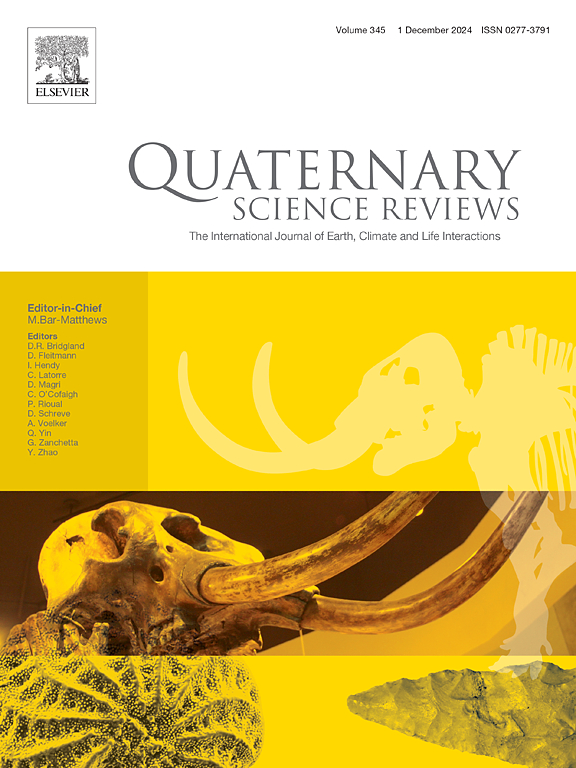Coupled sea-level and hydroclimatic controls on the southern Red Sea sedimentation during the past 30 ka
IF 3.2
1区 地球科学
Q1 GEOGRAPHY, PHYSICAL
引用次数: 0
Abstract
Sedimentation in the Red Sea basin is governed by the complex interplay between regional atmospheric circulation, precipitation patterns, and sea level fluctuations, which altogether exert a profound control on the detrital and biogenic components of the sedimentary record. To gain a comprehensive understanding of these controls on the southern Red Sea sedimentation over the past 30 ka, we here combine high-resolution bulk geochemical and mineralogical data with detrital grain-size distributions and plant-wax biomarkers at a sub-centennial average temporal resolution. Our proxies reveal that the sedimentary record is characterised by two distinct depositional regimes of detrital and marine origin. The pronounced shift from the detrital-dominated (ca. 30–14.6 kyr) to the marine-dominated phase (ca. 14.6–0.8 kyr) coincides with the end of Heinrich Event 1 and the rapid sea-level rise associated with Meltwater Pulse 1a. Flooding of the shelf during deglacial sea-level rise increased the distance between the core site and the respective shoreline, and partially controlled the delivery of detrital material to the site. Shifts in detrital grain-size distribution and mineralogical composition indicate a reduction in regional continental aridity and potentially weaker wind circulation with the onset of Greenland Interstadial-1, while the reestablishment of water-mass exchange with the Gulf of Aden from ca. 15 ka onwards led to a marine productivity surge at our study area. An increase of fine-grained fluvial material and terrestrial n-alkanes between ca. 16 and 8 ka points to the establishment of more pluvial conditions and the activation of local wadi runoff during the African Humid Period. Finally, the subtle but steady increase of detrital input from ca. 5 ka onwards suggests the re-establishment of continental aridity during the late Holocene.
过去30 ka来海平面和水文气候对红海南部沉积的耦合控制
红海盆地的沉积是由区域大气环流、降水模式和海平面波动之间复杂的相互作用控制的,它们共同对沉积记录的碎屑和生物成分产生深远的影响。为了全面了解过去30 ka对南红海沉积的控制,我们在这里将高分辨率的大块地球化学和矿物学数据与碎屑粒度分布和植物蜡生物标志物结合起来,达到了次百年平均时间分辨率。我们的代用物表明,沉积记录具有碎屑和海相两种不同的沉积制度。从碎屑为主阶段(约30-14.6 kyr)到海洋为主阶段(约14.6-0.8 kyr)的显著转变与海因里希事件1的结束和与融水脉冲1a相关的海平面快速上升相吻合。在冰期海平面上升期间,陆架的洪水增加了岩心地点与各自海岸线之间的距离,并在一定程度上控制了碎屑物质向岩心地点的输送。碎屑粒度分布和矿物组成的变化表明,随着格陵兰间冰期-1的开始,区域大陆干旱减少,风环流可能减弱,而从大约15 ka开始,与亚丁湾的水团交换的重建导致我们研究区域的海洋生产力激增。在大约16至8 ka之间,细粒河流物质和陆生正构烷烃的增加表明,在非洲湿润期,建立了更多的降雨条件,并激活了当地的河流径流。最后,从约5 ka开始,碎屑输入的细微但稳定的增加表明,在全新世晚期,大陆干旱的重新建立。
本文章由计算机程序翻译,如有差异,请以英文原文为准。
求助全文
约1分钟内获得全文
求助全文
来源期刊

Quaternary Science Reviews
地学-地球科学综合
CiteScore
7.50
自引率
15.00%
发文量
388
审稿时长
3 months
期刊介绍:
Quaternary Science Reviews caters for all aspects of Quaternary science, and includes, for example, geology, geomorphology, geography, archaeology, soil science, palaeobotany, palaeontology, palaeoclimatology and the full range of applicable dating methods. The dividing line between what constitutes the review paper and one which contains new original data is not easy to establish, so QSR also publishes papers with new data especially if these perform a review function. All the Quaternary sciences are changing rapidly and subject to re-evaluation as the pace of discovery quickens; thus the diverse but comprehensive role of Quaternary Science Reviews keeps readers abreast of the wider issues relating to new developments in the field.
 求助内容:
求助内容: 应助结果提醒方式:
应助结果提醒方式:


